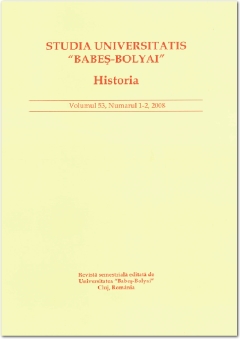Preliminaries for the history of the Romanian Communist Youth Union
Preliminaries for the history of the Romanian Communist Youth Union
Author(s): Adrian CioflâncăSubject(s): History
Published by: Studia Universitatis Babes-Bolyai
Keywords: Communism; Romania; Evolution of the Youth Communism Union; Youth Organizations of the RCP.
Summary/Abstract: This study stands for the author’s contribution to the Final Report of the Presidential Commission for the Analysis of the Communist Dictatorship in Romania, constituted in 2006 by the Romanian Presidency and chaired by Professor Vladimir Tismăneanu from the University of Maryland. So far, the history of the Romanian Communist Youth Union (CYU) was under-researched, mainly due to political reasons. Many of the postcommunist politicians were connected to CYU and they had no interest to facilitate the disclosure of the communist archives. The files of CYU – which are in a good condition and well organized – have only recently become available for researchers. The Romanian Communist Youth Union was part of the vast and complicate network of “mass-organizations” created by the communist regime in order to dissimulate its totalitarian nature. In Leninist terms, its main function was to be a “transmission belt” between the Communist Party and the society, specifically to its young part. In inter-war Romania, CYU was an illegal and marginal organization, with an intermittent history, being strictly controlled by Comintern through the Youth Communist International. It became stronger and a genuine mass-organization only after the Second World War, under the Protection of the Red Army and of the Soviet “Counselors”. After the installation of the communist regime, all the other youth organizations (political, religious, cultural and sport organizations) were disbanded. CYU was a Comsomol-like organization, apparently autonomous but in fact subordinated the Communist Party. It was meant to function as a political instrument for the social and political mobilization, for the ideological socialization of the young population, for the selection and formation of the new elite and for the social control. During Gheorghe Gheorghiu-Dej, the youth communist organization was repeatedly purged (mainly after 1949, 1952 and 1956) of social enemies (mainly “kulaks”) and political adversaries (former members of the democratic parties and of other types of organizations). Nicolae Ceausescu transformed the political regime into an “inclusion” type (the term belongs to Kenneth Jowitt), tending to include the entire population in communist organizations. At the end of the ’40s, CYU included 1/5 of the young population; in the ’50s, one third; in the seventies, half, and in the ’80s the vast majority of the youth. CYU was often engaged in repressive campaigns, being part of the nationalization and collectivization process, of the anti-students campaigns in the second half of the ’50s, of the purges of schools, universities, institutions, factories, of the army etc. Most of the CYU leaders subsequently had a significant career in the Romanian Communist Party.
Journal: Studia Universitatis Babes-Bolyai - Historia
- Issue Year: 52/2007
- Issue No: 1-2
- Page Range: 75-105
- Page Count: 31
- Language: English

